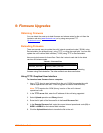
UDS1100 User Guide 65
1
1
1
1
:
:
T
T
r
r
o
o
u
u
b
b
l
l
e
e
s
s
h
h
o
o
o
o
t
t
i
i
n
n
g
g
a
a
n
n
d
d
C
C
o
o
n
n
t
t
a
a
c
c
t
t
I
I
n
n
f
f
o
o
r
r
m
m
a
a
t
t
i
i
o
o
n
n
This chapter discusses how you can diagnose and fix errors quickly without having to
contact a dealer or Lantronix. It helps to connect a terminal to the serial port while
diagnosing an error to view summary messages that may display. When
troubleshooting, always ensure that the physical connections (power cable, network
cable, and serial cable) are secure.
Note: Some unexplained errors might be caused by duplicate IP addresses on the
network. Make sure that your unit's IP address is unique.
When troubleshooting the following problems, make sure that the UDS1100 is
powered up. Confirm that you are using a good network connection.
LEDs
The UDS has the following LEDs, which help you diagnose problems.
Power LED (green)
Ethernet 10/100 Link (yellow = 10 Mb/green = 100 Mb)
Ethernet Half/Full Duplex Activity (yellow = Half Duplex/green = Full Duplex)
Diagnostic (red)
Status (green)
Simultaneously lit Diagnostic (red) and Status (green) LEDs mean something is
wrong. If the Diagnostic LED is lit or blinking, count the number of times the Status
LED blinks between its pauses. The following table explains the LED functions:
Table 11-1. UDS1100 LEDs
Condition Diagnostic LED Channel 1 Status LED
No Errors OFF N/A
Network controller error ON Blinks 3x/4 seconds
Serial number storage
checksum error
ON Blinks 4x/4 seconds
Duplicate IP address present ON Blinks 5x/4 seconds
No DHCP response Blinks 2x/second Blinks 5x/4 seconds
Setup menu active Blinks 2x/second Follows Diagnostic LED for 2
seconds, off for 2 seconds


















